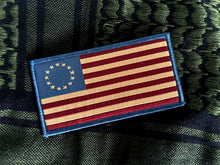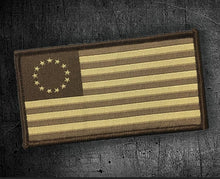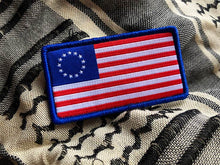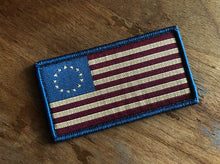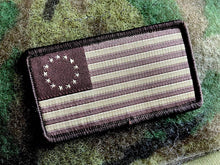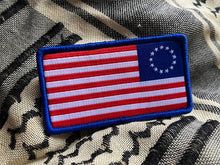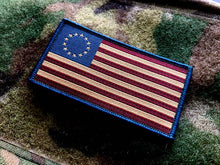Betsy Ross Flag
Texas 144.1
Regular price
$7.76
Sale
Despite the simplicity of the symbolism surrounding the flag,
Despite the questionable validity of Betsy Ross’ creation of the flag,
Despite the importance of other historical banners used to unite our people against the flag of Great Britain,
Despite which Presidents in recent years have, or have not proudly displayed this flag,
Despite the recent 'controversy' over the flag,
Despite everything;
The Betsy Ross flag is irrefutable and resolute as a foundational cornerstone of the American spirit which formed our country so very long ago. To forget this flag, or worse, to blot out the history of this standard, would be at the very least a treasonous act upon our heritage as a nation, as a state, as an American.
-Zac
-RED GATT
"Washington interpreted the symbolism of the flag as “We take the stars from Heaven, the red from our mother country, separating it by white stripes, thus showing that we have separated from her, and the white stripes shall go down to posterity representing Liberty.” - History of American Flags
Apocryphal?
Perhaps the best-known figure from the American Revolutionary era who wasn’t a president, general or statesman, Betsy Ross (1752-1836) became a patriotic icon in the late 19th century when stories surfaced that she had sewn the first “stars and stripes” U.S. flag in 1776. Though that story is likely apocryphal, Ross is known to have sewn flags during the Revolutionary War. - History.com
'The Truth About Betsy Ross’
Popular Lore Says She Made First Flag, but Evidence for the Tale Is Scarce
Americans love the story of Betsy Ross’s making the nation’s first official flag. For almost 140 years now, the tale of the plucky, practical Philadelphia seamstress has occupied a comfortable niche in the country’s patriotic pantheon alongside the stories of Paul Revere, the Minutemen, and Valley Forge.
Ross is so beloved and so deeply embedded in the nation’s memory that somehow it seems unpatriotic, if not vaguely treasonous, to cast doubt on her story. The truth, however, is that nobody can prove that Betsy Ross had
anything to do with the first official Stars and Stripes.
Marc Leepson is author of a popular 2005 history of Old Glory, Flag: An American Biography. He said in an interview, “As far as the big question is concerned—Did she make the first American flag?—every historical study has come to the same conclusion. There’s no good historical evidence that she did. But that doesn’t mean she didn’t. There’s simply a lack of documentation. Most historians believe the story is apocryphal.”
Congress recognized that the new nation needed a flag. On June 14, 1777, it passed the country’s first flag law. As legislation goes, it was refreshingly brief: “Resolved. That the flag of the United States be thirteen stripes, alternate red and white; that the union be thirteen stars, white in a blue field, representing a new constellation.”
From a twenty-first-century perspective, the Continental Congress’s lack of guidance on the flag’s appearance seems extraordinary. The law said nothing about the flag’s size, shape, or ordering of stripes or the size, type, or arrangement of stars. The legislation implicitly gave flag makers latitude for the creation. So the fledgling United States probably could have used somebody like Betsy Ross to get things organized. The first hint that she did,
however, did not surface nationally until almost a century after America declared independence from England. In 1870, her grandson, William Canby, told her story publicly for the first time, delivering a paper titled “The History
of the Flag of the United States” to the Historical Society of Pennsylvania.
According to Canby, Ross’s involvement with the flag began in 1776, a year before Congress passed its first flag resolution. He wrote:
Sitting sewing in her shop one day with her girls around her, several gentlemen entered. She recognized one of these as the uncle of her deceased husband, Col. George Ross, a delegate from Pennsylvania to Congress. She also knew the handsome form and features of the dignified, yet graceful and polite Commander in Chief, who, while he was yet Colonel Washington had visited her shop both professionally and socially many times, (a friendship caused by her connection with the Ross family) they announced themselves as a committee of
congress, and stated that they had been appointed to prepare a flag, and asked her if she thought she could make one, to which she replied, with her usual modesty and self reliance, that “she did not know but she could try; she had never made one but if the pattern were shown to her she had not doubt of her ability to do it.”
The committee produced a conceptual drawing. Seamstress Ross did not like the design and suggested improvements. Washington agreed with her, grabbed a pencil, and revised the drawing. Canby did not know what these changes were with one exception. The drawing showed six-pointed stars; seamstress Ross reportedly wanted five points. The committee members said they took too much effort. Canby wrote:
“Nothing easier” was her prompt reply and folding a piece of paper in the proper manner, with one clip of her ready scissors she quickly displayed to their astonished vision the five pointed star; which accordingly took its
place in the national standard. Canby relied on family oral accounts. None of Canby’s sources had witnessed Washington’s visit or his
grandmother making the flag. Instead, all said they had heard her tell the story many times. - History.org
Product Specs
- 3"x~1.75" (3.5x2" Vintage II )
- Woven for amazing detail
- Hook backing








